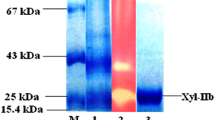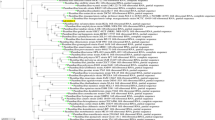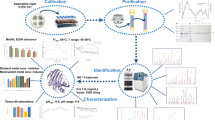Abstract
An extracellular, endo-β-1,4-xylanase was purified to homogeneity from the culture filtrate of the filamentous fungus Penicillium occitanis Pol6, grown on oat spelt xylan. The purified enzyme (PoXyn2) showed a single band on SDS–PAGE with an apparent molecular weight of 30 kDa. The xylanase activity was optimal at pH 3.0 and 65 °C. The specific activity measured for oat spelt xylan was 2,368 U mg−1. The apparent K m and V max values were 8.33 mg ml−1 and 58.82 μmol min−1 ml−1, respectively, as measured on oat spelt xylan. Thin-layer chromatography experiments revealed that purified PoXyn2 degrades xylan in an endo-fashion releasing xylobiose as main end product. The genomic DNA and cDNA encoding this protein were cloned and sequenced. This PoXyn2 presents an open reading frame of 962 bp, not interrupted by any introns and encoding for a mature protein of 320 amino acids and 29.88 kDa.






Similar content being viewed by others
References
Law, B.A. (2002). The nature of enzymes and their action in foods. In: Enzymes in food technology. Academic Press, 1–18.
Yin, Y. L., Baidoo, S. K., Jin, L. Z., Liu, Y. G., Schulze, H., & Simmins, P. H. (2001). The effect of different carbohydrolase and protease supplementation on apparent (ileal and overall) digestibility of nutrients of five hulless barley varieties in young pigs. Production Science, 71, 109–120.
Gübitz, G. M., Haltrich, D., Latal, B., & Steiner, W. (1997). Mode of depolymerization of hemicellulose by various mannanases and xylanases in relation to their ability to bleach softwood pulp. Applied Microbiology and Biotechnology, 47, 658–662.
Ganga, M. A., Pinaga, F., Vallés, S., Ramón, D., & Querol, A. (1999). Aroma improving in microvinification processes by the use of a recombinant wine yeast strain expressing the Aspergillus nidulans xlnA gene. International Journal of Food Microbiology, 47, 171–178.
Ebringerová, A., Kardošová, A., Hromádková, Z., Malovíková, A., & Høíbalová, A. (2002). Immunomodulatory activity of acidic xylans in relation to their structural and molecular properties. International Journal of Biology and Macromolecular, 30, 1–6.
Bajpai, P. (1997). Microbial xylanolytic enzyme systems. Advances in Applied Microbiology, 43, 141–194.
Belancic, A., Scarpa, J., Peirano, A., Díaz, R., Steiner, J., & Eyzaguirre, J. (1995). Penicillium purpurogenum produces several xylanases: purification and properties of two of the enzymes. Journal of Biotechnology, 41, 71–79.
Tuohy, M. G., Laffey, C. D., & Coughlan, M. P. (1994). Characterization of the individual components of the xylanolytic enzyme system of Talaromyces emersonii. Bioresource Technology, 50, 37–42.
Sandrim, V. C., Rizzatti, A. C. S., Terenzi, H. F., Jorge, J. A., Milagres, A. M. F., & Polizeli, M. L. T. M. (2005). Purification and biochemical characterization of two xylanases produced by Aspergillus caespitosus and their potential for kraft pulp bleaching. Process Biochemistry, 40, 1823–1828.
Sapag, A., Wouters, J., Lambert, C., de Ioannes, P., Eyzaguirre, J., & Depiereux, E. (2002). The endoxylanases from family 11: computer analysis of protein sequences reveals important structural and phylogenetic relationships. Journal of Biotechnology, 95, 109–131.
Collins, M., Galleni, A., & Matagne, M. (2005). Improving the alkalophilic performances of the Xyl1 xylanase from Streptomyces sp. S38: structural comparison and mutational analysis. Protein Science, 14, 292–302.
Vardakou, M., Dumon, C. W., Murray, J., Christakopoulos, P., Weiner, P. D., Juge, N., Lewis, J. R., Gilbert, J. H., & Flint, E. J. (2008). Understanding the structural basis for substrate and inhibitor recognition in eukaryotic GH11 xylanases. Journal of Molecular Biology, 375, 1293–1305.
Hadj Taieb, N., Chaabouni, S. E., Kammoun, A., & Ellouz, R. (1992). Purification and biochemical characterization of extracellular β-glucosidases from the hypercellulolytic Pol6 mutant of Penicillium occitanis. Applied Microbiology and Biotechnology, 37, 197–201.
Chaabouni, S. E., Belguith, H., Hsairi, I., Mkad, M., & Ellouz, R. (1995). Optimization of cellulase production by Penicillium occitanis Pol6. Applied Microbiology and Biotechnology, 43, 267–269.
Bailey, M. J., Biely, P., & Poutanen, K. J. (1992). Interlaboratory testing of methods for assay of xylanase activity. Biotechnology, 23, 257–270.
Miller, G. L. (1959). Use of dinitrosalicylic acid reagent for the determination of reducing sugars. Analytical Chemistry, 31, 426–428.
Driss, D., Bhiri, F., Elleuch, L., Bouly, N., Stals, I., Miled, N., Blibech, M., Ghorbel, R., & Chaabouni, S. E. J. (2011). Purification and properties of an extracellular acidophilic Endo-1,4-β-xylanase, naturally deleted in the “thumb”, from Penicillium occitanis Pol6. Process Biochemistry, 46, 1299–1306.
Mandels, M., & Weber, J. (1969). The production of cellulases. Advances in Chemistry Series, 95, 391–412.
Bradford, M. (1976). A rapid and sensitive method for the quantitation of microgram quantities of protein utilizing the principal of dye binding. Analytical Biochemistry, 72, 248–254.
Spiro, R. (1966). Analysis of sugar found in glycoproteins. Methods in Enzymology, 256, 3–26.
Laemmli, U. K. (1970). Cleavage of structural proteins during the assembly of the head of bacteriophage T4. Nature, 227, 680–685.
Ellouz, S. C., Mechichi, T., Limeme, F., & Merzouki, N. (1993). Purification and characterization of two low molecular weight of endoglucanases produced by Penicillium occitanis mutant Pol6. Journal of Biotechnology, 29, 229–242.
Hewick, R. M., Hunkapiller, M. W., Hood, L. E., & Dreyer, W. J. (1981). A gas–liquid solid phase peptide and protein sequanator. Journal of Biology and Chemistry, 256, 7990-7997.
Hall, T. A. (1999). BioEdit: a user-friendly biological sequence alignment editor and analysis program for Windows 95/98/NT. Nucleic Acids Symposium Series, 41, 95–98.
Aifa, M. S., Sayadi, S., & Gargouri, A. (1999). Heterologous expression of Lip H8 of Phanerochaete chrysosporium in Aspergillus niger. Biotechnology Letters, 21, 849–853.
Sanger, F., Nicklen, S., & Coulson, A. R. (1977). DNA sequencing with chainterminating inhibitors. National Academy of Science, 74, 5463–5467.
Altschul, S. F., Madden, T. L., Schaffer, A. A., Zhang, J., Zhang, Z., & Miller, W. (1997). Gapped BLAST and PSI-BLAST, a new generation of protein database search programs. Nucleic Acids Research, 25, 3389–3402.
Krisana, A., Rutchadaporn, S., Jarupan, G., Lily, E., Sutipa, T., & Kanyawim, K. (2005). Endo-1,4-β-xylanase from Aspergillus sp. niger BCC14405 isolated in Thailand: purification, characterization and gene isolation. Journal of Biochemistry and Molecular Biology, 38, 17–23.
Heo, S. E., Kwak, J. Y., Oh, H. W., Park, D. S., Bae, K. S., Shin, D. H., & Park, H. Y. (2006). Characterization of an extracellular xylanase in Paenibacillus sp. HY-8 isolated form an herbivorous longicorn beetle. Journal of Microbiology and Biotechnology, 16, 1753–1759.
Iefuji, H., Chino, M., Kato, M., & Iimura, Y. (1996). Acid xylanase from yeast Cryptococcus sp. S-2: purification, characterization, cloning, and sequencing. Bioscience, Biotechnology, and Biochemistry, 60, 1331–1338.
Polizeli, M. L. T. M., Rizzatti, A. C. S., Monti, R., Terenzi, H. F., Jorge, J. A., & Amorim, D. S. (2005). Xylanases from fungi: properties and industrial applications. Applied Microbiology and Biotechnology, 67, 577–591.
Kimura, T., Ito, J., Kawano, A., Makino, T., Kondo, H., Karita, S., Sakka, K., & Ohmiya, K. (2000). Purification, characterization and molecular cloning of acidophilic xylanase from Penicillium sp.40. Bioscience, Biotechnology, and Biochemistry, 64, 1230–1237.
Gashaw, M., Rajni, H. K., & Bo, M. (2006). Thermostable alkaline active endo-β-1-4-xylanase from Bacillus halodurans S7: purification and characterization. Enzyme and Microbial Technology, 39, 1492–1498.
Wang, S. L., Yen, Y. H., Shih, I. L., Chang, A. C., Chang, W. T., Wu, W. C., & Chai, Y. D. (2003). Production of xylanases from rice bran by Streptomyces actuosus A-151. Enzyme and Microbiology Technology, 33, 917–925.
Magnuson, T. S., & Crawford, D. L. (1997). Purification and characterization of an alkaline xylanase from Streptomyces viridosporus T7A. Enzyme and Microbiology Technology, 21, 160–164.
Li, K., Azadi, P., Collins, R., Tolan, J., Kim, J. S., & Eriksson, K. E. L. (2000). Relationships between activities of xylanases and xylan structure. Enzyme and Microbiology Technology, 27, 89–94.
Saha, B. C. (2002). Production, purification and properties of xylanase from a newly isolated Fusarium proliferatum. Process Biochemistry, 37, 1279–1284.
Jaskari, J., Kontula, P., Sittonen, A., Jousimies-Somer, M. S., & Poutanen, K. (1998). Oat betaglucan and xylan hydrolysates as selective substrates for Bifidobacterium and Lactobacillus strains. Applied Microbiology and Biotechnology, 49, 175–181.
Tison, M. C., Leroux, G. A., Lafond, M., Georis, J., Juge, N., & Berrin, J. G. (2009). Molecular determinants of substrate and inhibitors specifities of the Penicillium griseofulvum family 11xylanses. Biochemical and Biophysical Acta, 1794, 438–445.
Von Heijne, G. (1986). A new method for predicting signal sequence cleavage sites. Nucleic Acids Research, 14, 4683–4690.
Ko, E. P., Akatsuka, H., Moriyama, H., Shinmyo, A., Hata, Y., Katsube, Y., Urabe, I., & Okada, H. (1992). Site directed mutagenesis at aspartate and glutamate residues of xylanase from Bacillus pumilus. Biochemistry Journal, 288, 117–121.
Fushinobu, S., Ito, K., Konno, M., Wakagi, T., & Matsuzawa, H. (1998). Crystallographic and mutational analyses of an extremely acidophilic and acid-stable xylanase: biased distribution of acidic residues and importance of Asp37 for catalysis at low pH. Protein Engineering, 11, 1121–1128.
Tanaka, H., Okuno, T., Moriyama, S., Muguruma, M., & Ohta, K. (2004). Acidophilic xylanase from Aureobasidium pullulans: efficient expression and secretion in Pichia pastoris and mutational analysis. Journal of Bioscience and Bioengineering, 98, 338–343.
Acknowledgments
We express our gratitude to Prof. Gérard Tiraby and Dr. Henry Durand (Cayla Company, France) for kindly supplying the Penicillium occitanis (Pol6) strain used in this work. We are also grateful to Prof. Radhouane Ellouz for his stimulating and beneficial discussion. We thank Prof. Hafedh Mejdoub (FSS) for the sequencing of the NH2-terminus. We also thank Dr. Mohamed Eljawa (CBS) for the DNA sequencing. This work was supported financially by the “Ministère de l’Enseignement Supérieur, de la Recherche Scientifique et de la Technologie-Tunisia” through a grant to “Unité Enzyme et Bioconversion–ENIS.”
Author information
Authors and Affiliations
Corresponding author
Rights and permissions
About this article
Cite this article
Driss, D., Bhiri, F., Siela, M. et al. Purification and Properties of a Thermostable Xylanase GH 11 from Penicillium occitanis Pol6. Appl Biochem Biotechnol 168, 851–863 (2012). https://doi.org/10.1007/s12010-012-9824-3
Received:
Accepted:
Published:
Issue Date:
DOI: https://doi.org/10.1007/s12010-012-9824-3




